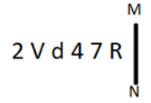31.
35 is related to 105 following a certain logic. Following the same logic, 51 is related to 153. To which of the following is 72 related, following the same logic?
(NOTE : Operations should be performed on the whole numbers, without breaking down the numbers into its constituent digits. E.g. 13 – Operations on 13 such as adding / subtracting / multiplying, etc., to 13 can be performed. Breaking down 13 into 1 and 3 then performing mathematical operations on 1 and 3 is not allowed.)

